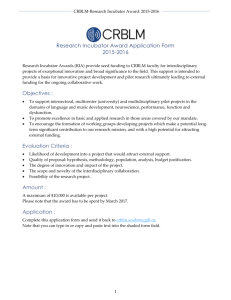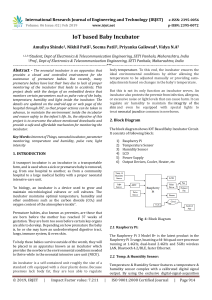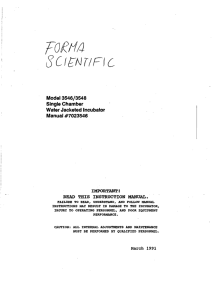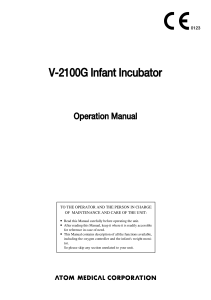BMT 365 ( Infant Incubator ) 1
advertisement
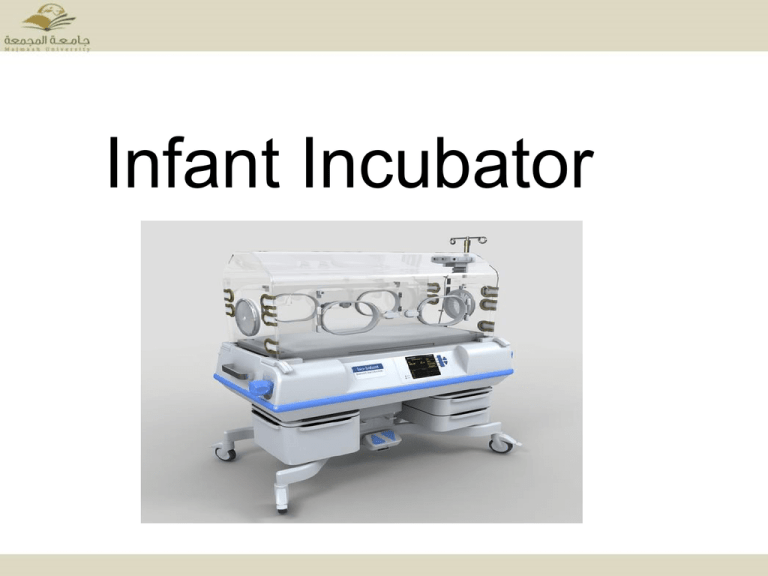
Infant Incubator Introduction • The core temperature of the human body is ~ 37 C. If the temperature goes too high or too down the organ can be damaged and illness or death can result. • The babies whose born before they are due to be born can be affected by the environment temperature and they can’t be able to regulate his temperature • The care of premature newborns requires that they be in an environment in which temperature is elevated and controlled because they are unable to regulate their own temperatures. • When infants are kept in a chamber maintained within a specific temperature range, O2 requirements are minimized. This is important for premature newborns, who are more susceptible to respiratory problems than full-term infants because their lungs may be unable to supply enough oxygen to meet elevated demands. • Heat lost happens as evaporation, conduction, convection or radiation. • Conduction is heat transfer between parts of the same material or different material which are adjacent to one another. • Convection is heat transfer from one material to another via a medium, such as air or water. • Radiation is heat transfer without any medium and through electromagnetic waves, such as between the Sun and the Earth. • Evaporation is heat absorption by liquids which then becomes a gas, such as when you boil water or simply leave a cup of water around and it is evaporated after a while. What is Infant Incubator • Any incubator is a special ENVIRONMENTAL CHAMBER designed for the specific purpose of allowing variable control, primarily of temperature, but some can and are being modified to vary ambient pressure and humidity also. • The human infant incubator, with for example, optional attachments such as an Oxygen delivery system, intravenous fluid infusion system, etc…, is designed to provide a "womb-like” environment for prematurely born infants. Main Functions of infant incubators Temperature Control O2 Concentration Control Breathing Gas Filtration Humidity Control Temperature Control • Temperature-controlled air is passed through the chamber in which the baby is located to maintain it at a set temperature. • Some incubators, instead of controlling the air temperature directly, use the skin temperature of the infant as a control parameter. • The thermistor is placed against the skin of the infant, and the controller is set to maintain the infant's skin at a given temperature. • If the infant is cooler than the set point, the air entering the chamber of the incubator is heated an amount proportional to the difference between the set temperature and the baby's actual temperature • Incubators also have a simple alarm system to alert the clinical staff if there is any dangerous overheating of the device. In some cases, the circuit also immediately reduces power to the heater to stop the overheating. Temperature degree regulator methods in Incubator • 1) Linear Method : automatic control (ON or Off) • 2) Proportional control method Incubator Types • Intensive Care Incubator • Transport Incubator • Radiant Warmer Transport Incubator Components of a transport incubator 1.Ventilator 2.monitor 3. suction 4. Temp and gas control 5.syringe drivers 6.battery and power supply 7. gas cylinders Simple Block Diagram Ventilation can be detected by one of the following methods: 1- Transthoracic impedance 2- Movement of the baby on a displacement detecting pad 3- Movement of the baby’s chest wall • An alarm is sounded when respiratory activity ceases for periods of greater than a preset time, in the range of 15 to 30 s . This is Apnea Alarm Technical specification: Air temperature: 32 – 38 C Body skin temperature: 34 – 36 C Total gas intake: 35L/min Relative humidity: 50- 100% Power supply: ac 220v,50 Hz Power input: 600 VA Sensor precision: 0.3 C Changing of temperature: 0.5 C Uniformity of temperature: 0.8 C Temperature rising time: 30 min Noise level: 55 dB Inclination of bassinet: 0ْ – 5ْ • Summarizing points • 1. Temperature-controlled air is passed through the chamber in which the baby is located to maintain it at a set temperature • 2. The temperature in the air-supply line varies a thermistor resistance that is compared with a fixed resistance that corresponds to the set temperature. • 3. If the temperature of the air entering the infant’s chamber is lower than the set temperature, power is applied to the heater to correct for this difference. • 4. The amount of power applied to the heater is proportional to the difference between the actual air temperature and the set point. • 5. The amount of power decreases as the temperature approaches the set point (this is important to minimize overshoot of the set point). • 6. It is important to detect when apnea has persisted for a given period of time • 7. Apnea monitors detect ventilation by one of the following methods: • A-Transthoracic impedance • B-Movement of the baby on a displacement detecting pad • C-Movement of the baby’s chest wall



